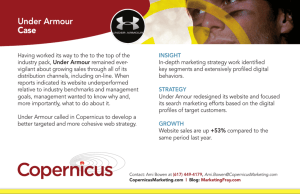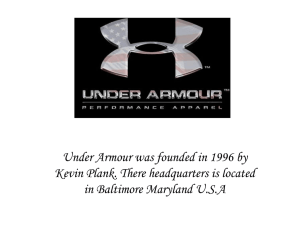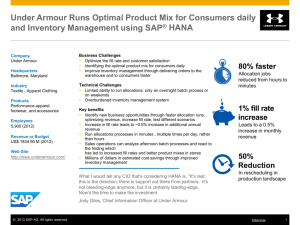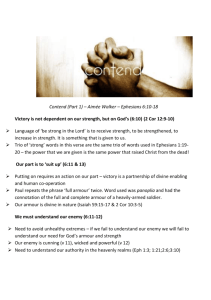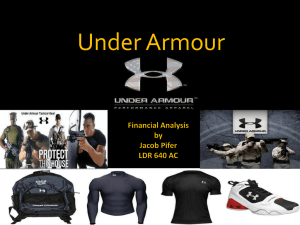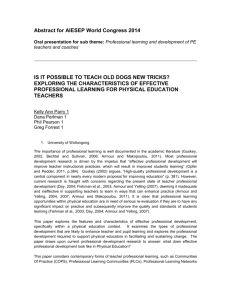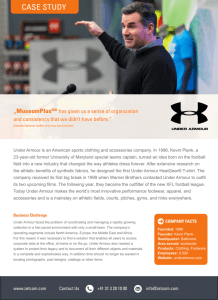here - Grafton Elliott
advertisement
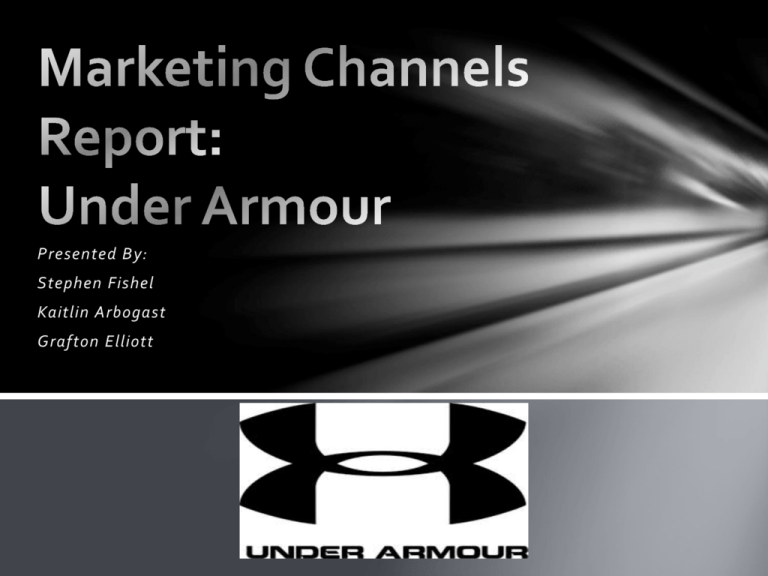
Presented By: Stephen Fishel Kaitlin Arbogast Grafton Elliott Company Profile: Background • One of the leaders today in the sporting clothes and accessories industry. • Based out of Baltimore, MD. • Annual sales around $2.25 billion dollars and continuing to grow. • Biggest competitor is Nike (Reebok, Adidas, Puma) • Annual revenue of around $25 billion (Yahoo Finance, 2014) Company Profile Cont… • Under Armour offers a total of five product lines: • • • • • Cold Gear Loose Gear Turf Gear All-Season Gear Heat Gear • Firm focuses on innovative products • • • Shirts that monitor heart rate Shoes that mimic the human spine Tape-replacing cleat http://www.youtube.com/watch?v=oYCvIr0fWnM Sporting Apparel Industry • Industry is expected to exceed $126 billion by 2015. • Market is driven by a trend toward healthier, more active lifestyles. • Older demographics and women becoming more active. • Consumers are demanding more versatile wear with wider functionality. • Retailers continue producing new styles of sports apparel. • Challenges faced by companies include fashion trends, tough competition, and more price-conscious shoppers. • Industry is highly fragmented with many brands competing with each other. (Report Linker, 2014) Target Market • Main Target- Athletes of both genders and all ages. • Also cater to every-day person • Loose Gear product line is catered to every-day casual wear. Stage #1: Need for Channel Design Decision • Today, UA uses a selective distribution strategy (multi-channel design). • Sell to both wholesale and retail as well as directly • Principal customers: Dick’s Sporting Goods, Eastbay, and Sports Authority. • Approximately 90.5% of net revenues are made from wholesale distribution. Selling Directly • Selling directly= competitive advantage. • E-commerce is growing and becoming the preferred way to shop by consumers. • Online retail sales expected to grow from $225.5 billion today to $434.2 billion in 2017 (U.S. E-commerce Sales). • Focus more on e-tailing while still selling wholesale. Selling Directly • UA could find a niche provided customers with personalized and customized products. • UA must keep up with competitors such as Nike and offer similar options. • Nike ID Stage #2: Distribution Objectives • Change is not necessarily needed but more focus on directly selling to consumer. • Overall distribution objective: Be the market share leader in the sporting apparel industry (UA Executive Summary, 2014). Congruency in Marketing Mix • Product, price, and promotion must be congruent with overall distribution objective. • Raised prices due to the nature of the product. • Customized and personalized products cost more to manufacture. • Promotion needs to be ramped up to raise awareness to consumers. Stage #3: Specifying Distribution Tasks • Effective distribution= sustainable advantage in online retail market. • Customization is a value co-creation method for consumers. • Involving customer in production process= attachment to company. Distribution Tasks • First task: Gathering marketing research on buying habits of target market. • Identification of products to customize. • Explore customization options. • Second Task: Promoting online sales/customization to target market. • Promotion in sporting goods stores and other retail locations. • Advertising (Internet and TV) Distribution Tasks • Third Task: Maintaining inventory storage • Customization option leads to new manufacturing methods and materials. • Maintaining inventory=ability to keep up with demand. • Fourth and Fifth Tasks: Successfully selling the product to consumers. • Fulfilling online orders • Staying ahead of the competition. Stage #4: Alternative Channel Structures • Everything begins with manufacturing plants. • UA’s products are primarily manufactured in Asia, Central and South America, and Mexico (Under Armour, 2014) • UA channel members MUST have the ability to perform multiple manufacturing steps. • Reduces costs • “Quick-Turn Special Make-Up” manufacturing shop in Glen Burnie, Maryland. Alternative Channel Structures • Two-level Channel Design: • Exclusive Distribution • Customers purchase products directly from Under Armour website . • Products are shipped using facilitating organization s (ship, plane, truck). • Three-level Channel Design: • Selective Distribution • Flow of products from manufacturer to wholesaler/retailer to end user. • Customers are encouraged to but at “Under Armour Brand Houses” • • Only 5 brand houses on east coast making accessibility limited. Under Armour seeks middle men who can perform a various number of production taks Channel Structures Cont… • Four-level Channel Design: • Most profitable channel structure used by Under Armour. • Intensive form of distribution. • Main benefit= increased level of customer service. Manufacturer Wholesaler Retailer End-user Stage #5: Evaluating Variables • Market Geography: • Under Armour has approximately 120 US “Brand Houses” within 49 states. • Speciality stores in Maryland, Massachusettes, and Illinois. • Factory House locations in 34 states from Maine to California also California. • International Locations: Hong Kong, Toronto, and the Netherlands. • Market Size: • Domestic and International operations. • Opportunity to reach customers all over the world making their market size substantially large. Evaluating Variables • Market Density: • Areas with higher density need less channel member support • I.e. Hong Kong, New York • Market Behavior: • Refers to customer buying behaviors. • Under Armour divides their target market between high level sports teams and individual consumers. • Individuals typically buy in small quantities based on sporting season. • Team orders are in bulk. • Under Armour sponsors many college athletic teams as well as professional teams such as the Baltimore Orioles and Baltimore Ravens. Evaluating Variables • Market Behavior: • Repeat purchases come from customers that need different attire according to sporting season. • Purchases can be made directly or from a variety of retail locations. • Who does the buying? • Parents purchase for children • College Institutions/athletes • Well accomplished athletes • Individuals themselves Evaluating Variables • Product Variables: • Degree of Standardization: Less need for intermediaries for customizable/personalized products. • Company Variables: • Most important are size, financial capacity, managerial expertise, and objectives and strategies. • Under Armour has high degree of flexibility in choosing channel structures due to their size. • Under Armour also has power bases: • Reward • Coercion • Expertise Evaluating Variables • Objectives and strategies: • UA needs a higher level of control over products since they are customized. • Limits the use of intermediaries. • Objectives include promotion. • Intermediary Variables: • Availability: Custom channel will be needed to provide strong technical expertise as well as custom-designed apparel and footwear. Evaluating Variables • Environmental Variables: Competitive Environment • Under Armour must be concerned about horizontal competition with companies such as Nike, Adidas, and Reebok. • Intertype competition with intermediaries such as Dick’s Sporting Goods and UA retail brand outlets. • Channel design should directly sell to consumer due to efficiency and effectiveness. • Competitive edge • Technological Environment: • Technology allows for customization to exist. • Internet provides Under Armour access to organizing and sharing unlimited amounts of information for consumers. Evaluating Variables • Behavioral Variables: Use of legitimate power • Under Armour has to be able to control its distribution objectives. • The company will have most, if not all, control over distribution when selling customized/personalized products. Stage #6: Choosing “Best” Channel Structure • Best design for individual customized products is a two-level design selling directly to the consumer. • Warehousing is necessary to store products before being shipped (similar to Amazon). • Bulk orders can be manufactured at facilities such as the one in Glen Burnie, Maryland. Stage #7: Selecting Channel Members • Selling directly to consumer, for the most part, does not necessarily require the need for channel members. • Current Under Armour distributors have: • Sales Strength -Dick’s Sporting Goods Revenue 2013: $6 Billion. (Market Watch) • Large Size- Large volumes of sales, established, profitable. • Market Coverage • Inducements from Under Armour: • Strong Product Lines. • Ability to provide advertising and promotional support. Questions? Sources • http://money.cnn.com/magazines/fortune/fortune500/2013/snapshots/11 068.html (Market Watch) • http://www.underarmour.com/shop/us/en (Under Armour) • http://finance.yahoo.com/ (Yahoo Finance) • http://www.reportlinker.com/ci02121/Sport-Clothing-andAccessories.html (Report Linker)
